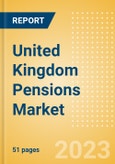Summary
The UK pensions market expanded strongly in 2022, recording a 10.6% rise to reach GBP15.4 billion in annual premium equivalent (APE). Work-based pensions achieved a very strong growth rate of 23.6% over the same period. Due to a rise in workplace pension enrolment, workplace pensions-which account for the bulk of pensions at 57.8%-played a key part in this rise. All other pension types contracted in 2022.This report examines how the pensions market is changing. Consumers are being encouraged to save in workplace and personal pensions at a time when the impacts of the cost-of-living crisis are squeezing the financials of many households. This report explores how consumers’ attitudes and behaviors towards long-term saving, planning for retirement, and accessing private pensions are changing. It provides current and historical data on the size of the market by product type, covering individual pensions, workplace pensions, and trust-based pensions. Data on common retirement products is also provided, while the size of the pensions market has been forecast to 2027.
Scope
- Single individuals (i.e., those not in a legally-recognized relationship) must supplement their state pension by over GBP14,000 per annum in order to achieve a moderate standard of living in retirement, given that the full state pension pays roughly GBP9,000.
- According to our 2023 UK Life and Pensions Survey, 61.9% of people contributed at least 6% of their salary towards their pension in 2023. 18.2% increased their pension contribution in 2023 despite the cost-of-living crisis.
- 56% of pension pots were completely withdrawn upon its first time accessed. 17.7% of over 55s decided to take money out of their pension plans. However, 62.8% of these people did not consult a financial expert, which may have led them to make financially reckless decisions.
Reasons to Buy
- Examine the size of the pensions market
- Discover how individuals save towards retirement
- Learn how individuals access their private pensions for the first time
- Understand trends in the income drawdown and annuities segments
- Explore the gender gap in pensions
- Understand the impact of the cost-of-living crisis on the market, sentiment, and customer behavior
Table of Contents
1. Executive Summary
2. The State Pension and Retirement Planning
3. Private Pensions: Market Size and Players
4. Saving for Retirement
5. Pension Decumulation
6. Lifestyle in Retirement
7. Appendix
List of Tables
List of Figures
Companies Mentioned (Partial List)
A selection of companies mentioned in this report includes, but is not limited to:
- BlackRock
- Royal London Mutual
- Aviva
- Lloyds Banking Group
- Phoenix Group
- M&G
- Fidelity International
- Liverpool Victoria Financial Services
- Vitality
- Wesleyan
- British Airways
- Royal Mail
- NatWest Group
- Cushon
- Smart Pension
- Evolve Pensions
- Rothesay Life
- Standard Life
- Chubb
- Agfa UK
- Sun Life UK
- Threadneedle
- Cobham Pension Plan
- NTL
- Pension Insurance Corporation (PIC)
- Just Group
- Canada Life
- Bfinance
- Uber








